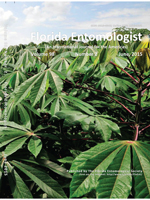We report the first description and analysis of acoustic signals and structures in the larger Mexican pine beetle, Dendroctonus approximatus (Coleoptera: Curculionidae: Scolytinae).We recorded acoustic signals during two behavioral contexts, disturbance and male-female interactions. The relationship between size and sound production was assessed by comparing temporal and spectral chirp characteristics with body size and sound-producing organs. During male-female interactions, males first produce the interrupted chirp, a relatively long chirp (x = 214.36 ± 5 ms) interspersed with periods of silence. Once inside female galleries, males switch to a simple chirp. Females produce chirps in response to male acoustic signals and disturbances. For male chirps produced in response to disturbance, frequency was positively correlated with the density of ridges on stridulatory structures and inversely correlated with beetle size characteristics. Small males were more likely to produce high frequency chirps when disturbed, compared with larger males. These results indicate that acoustic signals may be limited by morphology and size in bark beetles.
How to translate text using browser tools
1 June 2015
Characterization of Stridulatory Structures and Sounds of the Larger Mexican Pine Beetle, Dendroctonus approximatus (Coleoptera: Curculionidae: Scolytinae)
Kasey M. Yturralde,
Richard W. Hofstetter

Florida Entomologist
Vol. 98 • No. 2
June 2015
Vol. 98 • No. 2
June 2015
acoustic communication
bark beetle
body size
comunicación acústica
escarabajo de la corteza
órgano estridulador
stridulatory organ




